
The main problem with the ecological state of the waters in our country is impoverished morphology due to regulations, barriers to migration and pollution, both municipal and area-related. In the case of water systems, what is particularly visible is their inseparability and the effects of interference in a catchment on the condition of the rivers that drain them. These effects, combined with the effects of climate change and the increasing number of cases of supplementing the shortage of water for agriculture from groundwater resources, cause the permanent problem not of flooding, but of permanent drought in the vast majority of territory of Poland. The lack of water in rivers does not result from the rivers themselves, but from the condition of their catchments. 52% of our rivers’ supply comes from groundwater, hence the fact that the groundwater’s level has dropped by an average of more than 2 meters is related to the condition both in the river and in the valley, as well as in the entire catchment area. Monitoring studies carried out in the LIFEDrawaPL project clearly confirmed the serious shortcomings of this catchment in terms of natural retention, i.e. the proper level of water in the ground in the catchment area. In contrast, the proper condition of these waters is a key factor in stabilizing the condition of rivers, ensuring the resilience of the river system both in periods of no precipitation – stable underground supply giving a constant level of low water, as well as in periods of greater rainfall, when soaking into irrigated soil limits the faster surface runoff 20 times.
Natural diversity ensures the provision of many services, known as ecosystem services, which result in security – from access to usable water to the reduction of floods and droughts. Providing diversity also means reducing the negative impact of humans on climate change, by reducing the emission of carbon deposited in sediments of valleys, wetlands and peat bogs. At the same time, the hydromorphological diversity of watercourses ensures a high level of reduction of material from agricultural areas or other parts of the catchment area, limiting the contribution to the increasingly serious problem of lake and sea pollution, related to a higher eutrophication rate [Jekatierynczuk-Rudczyk 2014]. One of the manifestations of widespread interference was, and still in many regions is, interfering with the naturally diverse cross-sections and profiles of watercourses, including a removal of boulders, gravel and stone heights and the development of the watercourses’ banks, which in general significantly changes the way water flows, and at the same time reduces abiotic diversity of parts of the ecosystem, reducing biodiversity because of the absence of specific niches. At the same time, the lack of depth diversification brings significant changes in the energy of flowing waters, adversely affecting the behaviour of raised water stages. The reason is the omission of the importance of riffles and pools systems as a factor stabilizing water energy, and at the same time fulfilling many other roles, determining the presence of valuable habitats and species appropriate for them. A typical example is the disappearance of the habitat of water-crowfoots rivers for this reason. The action planned under the LIFEDrawaPL project is aimed at reversing this situation and initiating the presence of this habitat in sections with parameters appropriate for its presence. The analysis of the state of river basins covered by the project under State Monitoring 0 (http://drawalifeplus.rdos.szczecin.pl/wp-content/uploads/2015/02/Monitoring-stanu-pocz%C4%85tkowego-stan-warunk%C3%B3w-siedliskowych.pdf prompted the team to restore the diversity of morphology to the sections changed by humans.
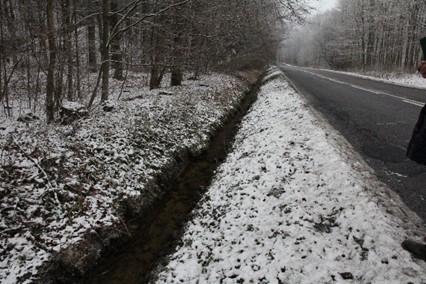
Despite much better condition of the Drawa basin than the national average, it also experienced interference in its natural condition. Some sections were regulated, including Drawa from its very sources, today in the reserve. However, the river bed itself is a wild, regulated in the past, channel up to the mouth at Lake Żerdno. To make matters worse, in the 1970s, the longitudinal profile was standardized, reducing the morphological diversity. The effects of these works can be felt especially in years with less rainfall. There is not enough water there. A similar situation is on the Drawa from Lake Drawsko, where the connection with Lake Rzepowskie has a lowered bottom, and the regulation of the river in Rzepowo also does not improve the situation. And we find the same condition on this river right up to the entrance to the military training area. Along the way, there are additionally several barriers to migration, currently cleared within the project, and in one case beyond it, on the Old Drawa, that is the natural bed of this river, cut off after the construction of the Borowo power plant and the Prostynia canal. There, the EW operator made the fish pass himself. As part of the state 0 monitoring studies, at the beginning of the project, research teams confirmed the deficiencies of the habitat’s state in various sections of the Drawa and its important tributaries. The research also revealed a significant difference in the ecological condition between the upper and middle course of this river and its lower section. While in the lower section within the area of the Drawieński National Park, the only drawback was the lack of gravel and stone morphological structures, damaged by many decades of using of the lower section from the estuary to the EW Kamienna, the deficiencies in the condition of the river habitats in the higher sections were found to be much wider. The use of this part of the catchment has left its mark on the river and its valley, resulting in a reduction of the habitat of the water-crowfoots rivers virtually to zero. In all cases, the most beneficial solution to the identified problems, based on the experiences that are becoming more numerous even in our country, was to restore the diversity of the river bed’s morphology.
The scientific background of these activities results from a modern knowledge about the ecology of waters. Over the centuries, the man has greatly interfered into a surrounding landscape for many reasons. Partly, it was the need to make fertile parts of river valleys or wet basins available, partly to remove obstructions hindering transport, as in the case of the Drawa, wood, and another – to develop the floodplain part of the valley. The effects include increasing problems with the proper degree of soil irrigation, as well as reducing the resistance of ecosystems to extreme phenomena. The reason is the loss of a natural diversity that determines the entire package of services that were not noticed until recently. Meanwhile, the appropriate state of biodiversity is a key condition for maintaining the good condition of waters and ecosystems dependent on waters, which reflects directly in ensuring the utility value of the catchment area [Geist 2011].


Photos 1 and 2 The initial course of the Drawa, like many other rivers in Poland, is a wild canal flowing between the lakes. From the very beginning, the basin and the valley are subject to drainage, as a result of which, in periods without precipitation, the river is poorly supplied with groundwater, which translates into the hydrological situation in the lower section. The river in its entire section requires restoration activities, but due to the proximity of the road, they are complicated and require comprehensive activities in the valley.
As part of the project, measures were taken to prevent excessive low flows by segmental reconstruction of the nature-like diversity of morphology using the principles of creating riffle-pool sequences, however, it was not possible to restore the entire basin from the very sources.
More information about the principle and the scientific basis of rivers’ restoration as the best method of restoring ecosystem services provided by catchment and watercourse systems can be found in the literature, e.g. in the National Program for Surface Water Restoration, https://www.wody.gov.pl/images/Aktualnosci/foto/renaturyzacjaKPRWP/Podrecznik_renaturyzacji.pdf, in the Expertise “Water in agriculture” https://koalicjazywaziemia.pl/ekspertyza-woda-w-rolnictwie/ and in several other studies. In some of them you will find studies by people participating in the LIFEDrawaPL project.
We leave the rest to nature, although research shows that the Drawa catchment area requires some continuation of the restoration. The funds available under the project made it possible to carry out the tasks as planned.
In October, our activities were completed, the main goal of which was to enrich the morphology of the riverbeds in the Drawa basin, the Drawa itself and the nearby areas of Natura 2000 covered by the project, the Radwia, Chotla and Chociela and Grabowa Valley.
As part of the action, over the course of almost 3 years, more than 60 piles were made in riffle – pool systems, including: 15 piles on the River Drawa section from the mouth from Lake Prosinko to Złocieniec, 10 piles on the River Drawa section in Drawsko Pomorskie , 7 piles on the Korytnica and Płociczne, 16 piles on the section of the River Drawa from the estuary of the Płociczna River with the Korytnica River on the section from the weir in the town of Sówka to the estuary of the Drawa to the bridge on road No. 22 and a total of 17 piles on the rivers Radwia, Chociela, Grabowa and Dręznianka.
The graining used in the construction of the piles can be divided into two groups, a mixture with a median of 22 mm in the range from 0 to 63 mm as a building material to support the piles – from the side of the water inflow, and a mixture thicker with a median of 32 mm, in the range from 2 to 190 mm as building material of the piles’ slopes. The thinner mixture is also an excellent spawning substrate for lithophilic fish in terms of reproduction. The thicker mixture, in terms of grain size, results from the measurements and calculations of the stream power /watercourse’s energy / at each location. The differences in the grain size for individual locations, resulting from the calculations using the equilibrium equations of the stable natural gravel-bottom rivers of Hey-Thorne1, were small, and the substrate could be adjusted when implementing each sequence.
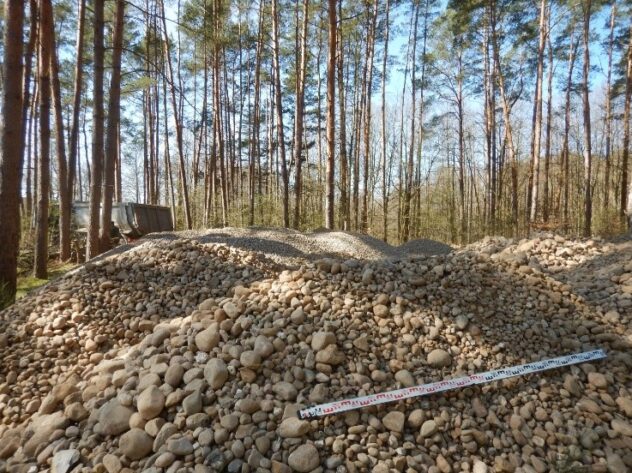
Raw material batches were checked before being introduced into the river beds. The photo shows a set of ingredients to be mixed into a pile in the Drawa River. The selection of specific proportions based on the graining curves was consulted with the expert of the Steering Group, Józef Jeleński, and supervised by the field coordinator and the supervision inspector on behalf of the Contract Engineer.
In wider sections of the watercourses, the works required a “technological route” to ensure that the substrate was located from shore to shore. It is an important element of arranging piles. Leaving part of the bed uncovered with gravel initiates erosion if the water meets less resistant deposits.


For the contractor, the Jaranowski company, it was also a lesson in the performance of restoration activities, not only in terms of the selection of materials and the execution of piles in accordance with the projects, but also in terms of logistics. Most of the locations were located in forest or agricultural areas, but the biggest challenge was the set of 10 piles in Drawsko Pomorskie.
The Drawa River was covered by actions from Lake Prosino, where the regulatory activities in the 1970s consisted in standardizing the longitudinal profile. The result of these works was a significant reduction of the waters in the Drawa valley, and thus the reduction of valley and channel retention. The best solution for such “cavities” is to recreate the natural-like differentiation of the bottom of the channel. The action limited the leakage of water from the lake, in the long term giving the opportunity to improve the water conditions in the area and reduce low flows, which have recently resulted in a decrease in flow almost to zero.

Location before the reconstruction of the piles removed in the 70’s of the last century. The Drawa on this section was a beautiful gravel-bottom stream until an ill-considered regulation in the 70s of the last century.
Below, the state of the Drawa under the bridge in Prosinek before the beginning of work. Flow rate of several liters per second.


Prosinko. The pile below the bridge is under construction. During works, it is impossible to avoid temporary turbidity of the water, but it is a temporary phenomenon and disappears on a short distance, as long as the substrate is not muddy.
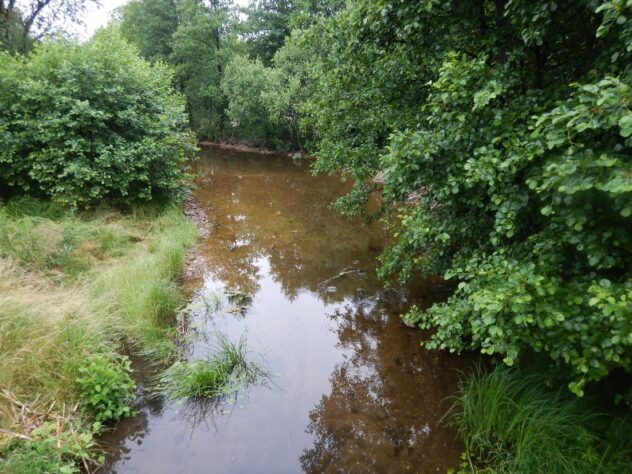
View of the pile at the mouth of the Drawa from Lake Prosino above the bridge in Prosinek. Before the operation, the water in summer disappeared almost to zero, as in the photo above, seeping in the bottom sediments here.
Another chosen place is Kuźnica Drawska, where the same actions had a similar effect, every summer the river bed almost completely drying up, with the wet meadows in the valley drying out. This situation results in weaker feeding of the section downstream of the area.


Czaplinek Canal. On this object an attempt was made to stabilize the water level with stake fences. The solution did not live up to expectations, instead of improving the situation, by preventing fish from entering the channel. The location is difficult due to the buildings on both sides. The introduction of a sequence of short piles improved the situation, eliminating the hindrance effect on fish migration.







Successive sequences of piles were made in the area of Głęboczek, above and below the remains of the weir at the historic mill, or rather, its remains falling into decline.
The piles on the backwater of the weir do not look so impressive, because their location in the zone of the dying current slightly blurs the visual effect, but they play the same role of stabilizing low water and enriching the diversity. In this section, there are numerous species associated with the gravel bottom, including brook lampreys and spined loachs.

At the stage of preparation of the restoration activities, the plan of arranging a sequence of piles on the Drawsko Pomorskie section of the Drawa River was of particular concern among many parties to the decision-making process. In the first place there were concerns about flooding during the high water season. Only detailed calculations for individual locations and demonstration of the insignificant impact of the diversified bottom morphology on the passage of a flood wave calmed the fears to the extent that the permits necessary in the current legal system were obtained and the action could be performed. In the summer, the contractor completed operations in this city. In Drawsko itself, there were 9 piles and one below the city. Near Mielenko Drawskie. Monitoring studies confirmed the rightness of this location. The water flowing in from the most agricultural part of the catchment between Złocieniec and Drawsko, where the Drawa’s riverbed was subjected to numerous interferences reducing the level of self-cleaning of the river system, had the worst parameters in monitoring studies 0. After the restoration, on final piles, the water again has sufficient parameters for the most demanding group of aquatic fauna, specific to the rivers of the salmonids land.








In Mielenko, the activities on the central Drawa have been completed. The original intention was to carry out similar activities on the Drawa’s old riverbed, called the Stara Drawa, now thanks to a fish pass made by the operator of the hydroelectric power plant in Borów, cleared. Due to the limited access, this location was abandoned and the contractor was directed to alternative locations of similar ecological importance, on the upper Płociczna and the upper Korytnica near Mirosławiec, in both cases on previously heavily changed sections. The changes found affect the ecological functions of both rivers in a significant part of their course. In both cases, the interference was caused by the desire to drain wetlands for their agricultural use. Currently, the effects are counterproductive, areas are drying out, but they are still unsuitable for agricultural use, and at the same time making the surrounding areas more susceptible to drought. The indentation of the source section of the Płociczna is particularly negatively visible in the degradation of the spring floodplain forests associated with wetlands. Both rivers are important tributaries of the Drawa, and themselves they are in a good ecological state in some sections, which, however, due to the deteriorating condition of groundwater and the supply of water to the watercourses with them, becomes threatened.
The next section planned for restoration was the vicinity of the mouth of the Sucha River, where experts of the DNP reported the risk of covering patches of water-crowfoots in the Drawa’s bed with sediments deposited by the Sucha after rains. The cause was the run-off of rainwater from a long part of the road, which eroded the sandy escarpment and carried large amounts of sand to the nearby Drawa. Performing a borehole and diverting the waters to the other side of the road in conjunction with the repair of the Sucha’s bed in the form of a nature-like bottom ramp eliminated the problem. To improve the condition of the Drawa itself, a sequence of piles was made, recreating a morphology close to the natural one.










Apart from the Drawa’s bed, the restoration activities included the tributaries, the Korytnica and the upper Płociczna. The morphological condition of both watercourses varies greatly depending on the section. Below Jaźwiny, on the lower Korytnica, the sediment transport was stopped as a result of two weirs, and the reservoirs themselves, reducing the variability of the river levels, limited the possibility of spontaneous replenishment of the gravel substrate. Without this gravel supplementation, the salmon’s spawners with a few strokes of their tail exposed the clay at the bottom of the river, and the mounds were too small for a good incubation of laid eggs. Below, there are some photos from before the action.





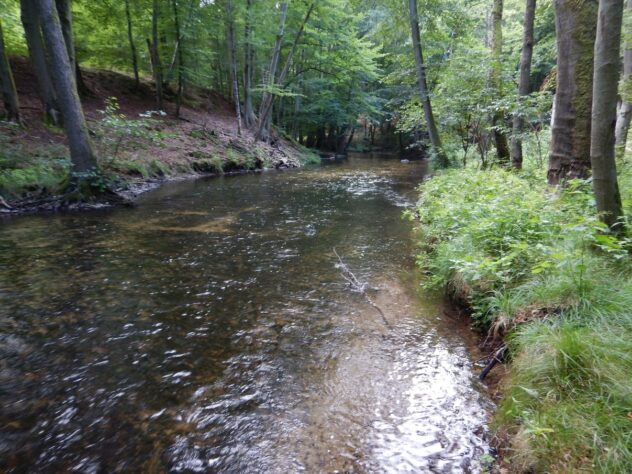








Another area of activity was the upper Korytnica near Mirosławiec. In this case, for many years the river’s section was maintained by “desludging”, as a result of which the water course was deepened and the adjacent wetland habitats were degraded, to the detriment of both themselves and the proper water conditions in the valley of the watercourse. This form of maintenance is one of the reasons for increasing problems with drought in periods without rain, and sudden flooding after each heavy rain. In this section, together with PGW WP, a remedial program has been agreed by sectional raising of the bottom elevation with gravel and stone piles. The watercourse has few water-crowfoots, but its potential to restore a good ecological condition is high on the Korytnica.








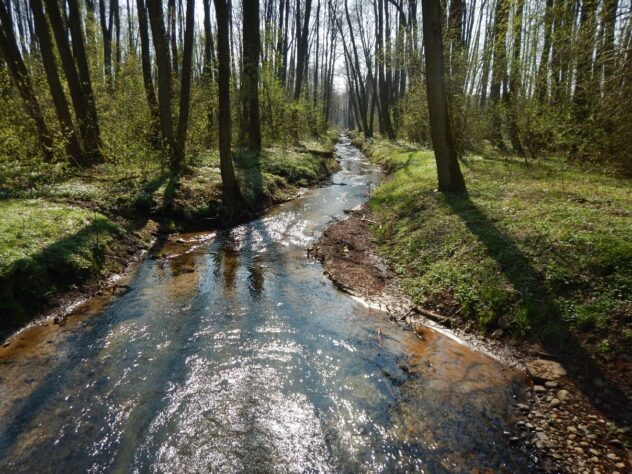



The tasks carried out on the Chociela, Radwia and Drężnianka will be presented in the next report.
Zadania przeprowadzone na Chocieli, Radwii i Drężniance zostaną przedstawione w kolejnym doniesieniu.
As a result of the project activities, much of the Drawa and its tributaries have been improved. However, further actions are necessary on the section of the Drawa between Złocieniec and Drawsko Pomorskie and on the upper section in the reserve of 5 lakes, which may be the subject of a separate project.
Literature:
- Thorne C. R., Hey R. D., Newson M. D., „Applied Fluvial Geomorphology for River Engineering and Management”. Wiley, Chichester 1997 r.
- Możliwe techniczne i biologiczne interwenje w utrzymaniu rzek górskich – Józef Jeleński
https://docplayer.pl/105460855-Kik-37-tarliska-gornej-raby-utrzymanie-rzek-gorskich.html - http://drawalifeplus.rdos.szczecin.pl/wp-content/uploads/2015/02/Monitoring-stanu-pocz%C4%85tkowego-stan-warunk%C3%B3w-siedliskowych.pdf